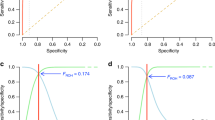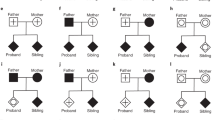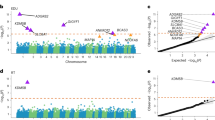Abstract
Inbreeding depression refers to lower fitness among offspring of genetic relatives. This reduced fitness is caused by the inheritance of two identical chromosomal segments (autozygosity) across the genome, which may expose the effects of (partially) recessive deleterious mutations. Even among outbred populations, autozygosity can occur to varying degrees due to cryptic relatedness between parents. Using dense genome-wide single-nucleotide polymorphism (SNP) data, we examined the degree to which autozygosity associated with measured cognitive ability in an unselected sample of 4854 participants of European ancestry. We used runs of homozygosity—multiple homozygous SNPs in a row—to estimate autozygous tracts across the genome. We found that increased levels of autozygosity predicted lower general cognitive ability, and estimate a drop of 0.6 s.d. among the offspring of first cousins (P=0.003–0.02 depending on the model). This effect came predominantly from long and rare autozygous tracts, which theory predicts as more likely to be deleterious than short and common tracts. Association mapping of autozygous tracts did not reveal any specific regions that were predictive beyond chance after correcting for multiple testing genome wide. The observed effect size is consistent with studies of cognitive decline among offspring of known consanguineous relationships. These findings suggest a role for multiple recessive or partially recessive alleles in general cognitive ability, and that alleles decreasing general cognitive ability have been selected against over evolutionary time.
This is a preview of subscription content, access via your institution
Access options
Subscribe to this journal
Receive 12 print issues and online access
$259.00 per year
only $21.58 per issue
Buy this article
- Purchase on Springer Link
- Instant access to full article PDF
Prices may be subject to local taxes which are calculated during checkout


Similar content being viewed by others
References
Carroll JB . Human Cognitive Abilities: A Survey of Factor-analytic Studies. Cambridge University Press: New York, NY, 1993.
Johnson W, Bouchard TJ, Krueger RF, McGue M, Gottesman II . Just one g: consistent results from three test batteries. Intelligence 2004; 32: 95–107.
Johnson W, Nijenhuis Jt, Bouchard TJ . Still just 1g: Consistent results from five test batteries. Intelligence 2008; 36: 81–95.
Batty GD, Deary IJ, Gottfredson LS . Premorbid (early life) IQ and later mortality risk: systematic review. Ann Epidemiol 2007; 17: 11.
Deary IJ, Weiss A, Batty GD . Intelligence and personality as predictors of illness and death: How researchers in differential psychology and chronic disease epidemiology are collaborating to understand and address health inequalities. Psychol Sci Public Interest 2010; 11: 53–79.
Gottfredson LS, Deary IJ . Intelligence predicts health and longevity, but why? Curr Dir Psychol Sci 2004; 13: 1–4.
Strenze T . Intelligence and socio-economic success: a meta-analytic view of longitudinal research. Intelligence 2007; 35: 401–426.
Erlenmeyer-Kimling L, Jarvik LF . Genetics and intelligence: a review. Science 1963; 142: 3.
Bouchard TJ, McGue M . Familial studies of intelligence: a review. Science 1981; 212: 5.
Deary IJ, Johnson W, Houlihan LM . Genetic foundations of human intelligence. Human Genetics. 2009; 126: 18.
Deary IJ, Yang J, Davies G, Harris SE, Tenesa A, Liewald D et al. Genetic contributions to stability and change in intelligence from childhood to old age. Nature 2012; 482: 212–215.
Benyamin B, Pourcain BS, Davis OS, Davies G, Hansell NK, Brion M-JA et al. Childhood intelligence is heritable, highly polygenic and associated with FNBP1L. Mol Psychiatry 2014; 19: 6.
Davies G, Tenesa A, Payton A, Yang J, Harris SE, Liewald D et al. Genome-wide association studies establish that human intelligence is highly heritable and polygenic. Mol Psychiatry. 2011; 16: 996–1005, 11.
Marioni RE, Davies G, Hayward C, Liewald D, Kerr SM, Campbell A et al. Molecular genetic contributions to socioeconomic status and intelligence. Intelligence 2014; 44: 7.
Afzal M . Consequences of consanguinity on cognitive behavior. Behav Genet 1988; 18: 12.
Agrawal N, Sinha SN, Jensen AR . Effects of inbreeding on raven matrices. Behav Genet 1984; 14: 7.
Badaruddoza, Afzal M . Inbreeding depression and intelligence quotient among north Indian children. Behav Genet 1993; 23: 343–347.
Bashi J . Effects of inbreeding on cognitive performance. Nature 1977; 266: 3.
Morton NE . Effect of inbreeding on IQ and mental retardation. Proc Natl Acad Sci USA 1978; 75: 3906–3908.
Woodley MA . Inbreeding depression and IQ in a study of 72 countries. Intelligence 2009; 37: 268–276.
Charlesworth D, Willis JH . The genetics of inbreeding depression. Nat Rev Genet 2009; 10: 783–796.
Mukai T, Cardellino RA, Watanabe TK, Crow JF . The genetic variance for viability and its components in a local population of Drosophila melanogaster. Genetics 1974; 78: 1195–1208.
Houle D, Hoffmaster DK, Assimacopoulos S, Charlesworth B . The genomic mutation rate for fitness in Drosophila. Nature 1992; 359: 58–60.
McQuillan R, Leutenegger A-L, Abdel-Rahman R, Franklin CS, Pericic M, Barac-Lauc L et al. Runs of homozygosity in European populations. Am J Hum Genet 2008; 83: 359–372.
Nothnagel M, Lu TT, Kayser M, Krawczak M . Genomic and geographic distribution of SNP-defined runs of homozygosity in Europeans. Hum Mol Genet 2010; 19: 2927–2935.
Kirin M, McQuillan R, Franklin CS, Campbell H, McKeigue PM, Wilson JF . Genomic Runs of Homozygosity Record Population History and Consanguinity. PLoS One 2010; 5: e13996.
Carothers AD, Rudan I, Kolcic I, Polasek O, Hayward C, Wright AF et al. Estimating human inbreeding coefficients: comparison of genealogical and marker heterozygosity approaches. Ann Hum Genet 2006; 70: 11.
Keller MC, Visscher PM, Goddard ME . Quantification of inbreeding due to distant ancestors and its detection using dense single nucleotide polymorphism data. Genetics 2011; 189: 13.
Ku CS, Naidoo N, Teo SM, Pawitan Y . Regions of homozygosity and their impact on complex diseases and traits. Hum Genet 2011; 129: 15.
Power RA, Nagoshi C, DeFries JC, Consortium WTCC, Plomin R . Genome-wide estimates of inbreeding in unrelated individuals and their association with cognitive ability. Eur J Hum Genet 2014; 22: 386–390.
Keller MC, Simonson MA, Ripke S, Neale BM, Gejman PV, Howrigan DP et al. Runs of homozygosity implicate autozygosity as a schizophrenia risk factor. PLoS Genet 2012; 8: e1002656.
McQuillan R, Eklund N, Pirastu N, Kuningas M, McEvoy BP, Esko T et al. Evidence of inbreeding depression on human height. PLoS Genet 2012; 8: e1002655.
Verweij KJH, Yang J, Lahti J, Veijola J, Hintsanen M, Pulkki-Raback L et al. Maintenance of genetic variation in human personality: testing evolutionary models by estimating heritability due to common causal variants and investigating the effect of distant inbreeding. Evolution 2012; 66: 3238–3251.
Lencz T, Knowles E, Davies G, Guha S, Liewald DC, Starr JM et al. Molecular genetic evidence for overlap between general cognitive ability and risk for schizophrenia: a report from the Cognitive Genomics consorTium (COGENT). Mol Psychiatry 2014; 19: 168–174.
International HapMap C International HapMap C, Frazer KA, Ballinger DG, Cox DR, Hinds DA, Stuve LL et al. A second generation human haplotype map of over 3.1 million SNPs. Nature 2007; 449: 851–861.
Purcell S, Neale B, Todd-Brown K, Thomas L, Ferreira MA, Bender D et al. PLINK: a tool set for whole-genome association and population-based linkage analyses. Am J Hum Genet 2007; 81: 559–575.
Howrigan DP, Simonson MA, Keller MC . Detecting autozygosity through runs of homozygosity: a comparison of three autozygosity detection algorithms. BMC Genomics 2011; 12: 460.
Laurie CC, Doheny KF, Mirel DB, Pugh EW, Bierut LJ, Bhangale T et al. Quality control and quality assurance in genotypic data for genome-wide association studies. Genet Epidemiol 2010; 34: 12.
Alper CA, Larsen CE, Dubey DP, Awdeh ZL, Fici DA, Yunis EJ . The haplotype structure of the human major histocompatibility complex. Hum Immunol 2006; 67: 73–84.
Bersaglieri T, Sabeti P, Patterson N, Vanderploeg T, Schaffner S, Drake J et al. Genetic signatures of strong recent positive selection at the lactase gene. Am J Hum Genet 2004; 74: 1111–1120.
Valero R, Marfany G, Gonzalez-Angulo O, Gonzalez-Gonzalez G, Puelles L, Gonzalez-Duarte R . USP25, a Novel Gene Encoding a Deubiqiutinating Enzyme, is Located in the Gene-Poor Region of 21q11.2. Genomics 1999; 62: 395–405.
Joshi PK, Esko T, Mattsson H, Eklund N, Gandin I, Nutile T et al. Directional dominance on stature and cognitiion in diverse human populations. Nature 2015; 523: 459–462.
Abdellaoui A, Hottenga J-J, Xiao X, Scheet P, Ehli EA, Davies GE et al. Association between autozygosity and major depression: stratification due to religious assortment. Behav Genet 2013; 43: 13.
Abdellaoui A, Hottenga J-J, Willemsen G, Bartels M, Tv Beijsterveldt, Ehli EA et al. Educational attainment influences genetic variation through migration and assortative mating. PLoS One 2014; 10: e0118935.
Acknowledgements
We acknowledge Bruce Walsh, Ken Krauter and Brian Browning for their helpful comments and suggestions in the preparation of this manuscript. This work has been supported by grants from the National Institutes of Health: R01 MH079800 and P50 MH080173 to AKM. RC2 MH089964 to TL. R01 MH080912 to DCG K23 MH077807 to KEB. K01 MH085812 and R01 MH100141 to MCK. The LOGOS study was supported by the University of Crete Research Funds Account (E.L.K.E.1348). The TOP Study Group was supported by the Research Council of Norway grants 213837 and 223273, South-East Norway Health Authority grants 2013–123, and K.G. Jebsen Foundation. The NCNG study was supported by Research Council of Norway grants 154313/V50 and 177458/V50. The NCNG GWAS was financed by grants from the Bergen Research Foundation, the University of Bergen, the Research Council of Norway (FUGE, Psykisk Helse), Helse Vest RHF and Dr Einar Martens Fund.
Author information
Authors and Affiliations
Corresponding authors
Ethics declarations
Competing interests
The authors declare no conflict of interest.
Additional information
Supplementary Information accompanies the paper on the Molecular Psychiatry website
Supplementary information
PowerPoint slides
Rights and permissions
About this article
Cite this article
Howrigan, D., Simonson, M., Davies, G. et al. Genome-wide autozygosity is associated with lower general cognitive ability. Mol Psychiatry 21, 837–843 (2016). https://doi.org/10.1038/mp.2015.120
Received:
Revised:
Accepted:
Published:
Issue Date:
DOI: https://doi.org/10.1038/mp.2015.120
This article is cited by
-
Associations of genome-wide and regional autozygosity with 96 complex traits in old order Amish
BMC Genomics (2023)
-
Whole-genome resequencing analysis of 20 Micro-pigs
Genes & Genomics (2020)
-
Assessing runs of Homozygosity: a comparison of SNP Array and whole genome sequence low coverage data
BMC Genomics (2018)
-
Runs of homozygosity: windows into population history and trait architecture
Nature Reviews Genetics (2018)
-
Effects of autozygosity and schizophrenia polygenic risk on cognitive and brain developmental trajectories
European Journal of Human Genetics (2018)



